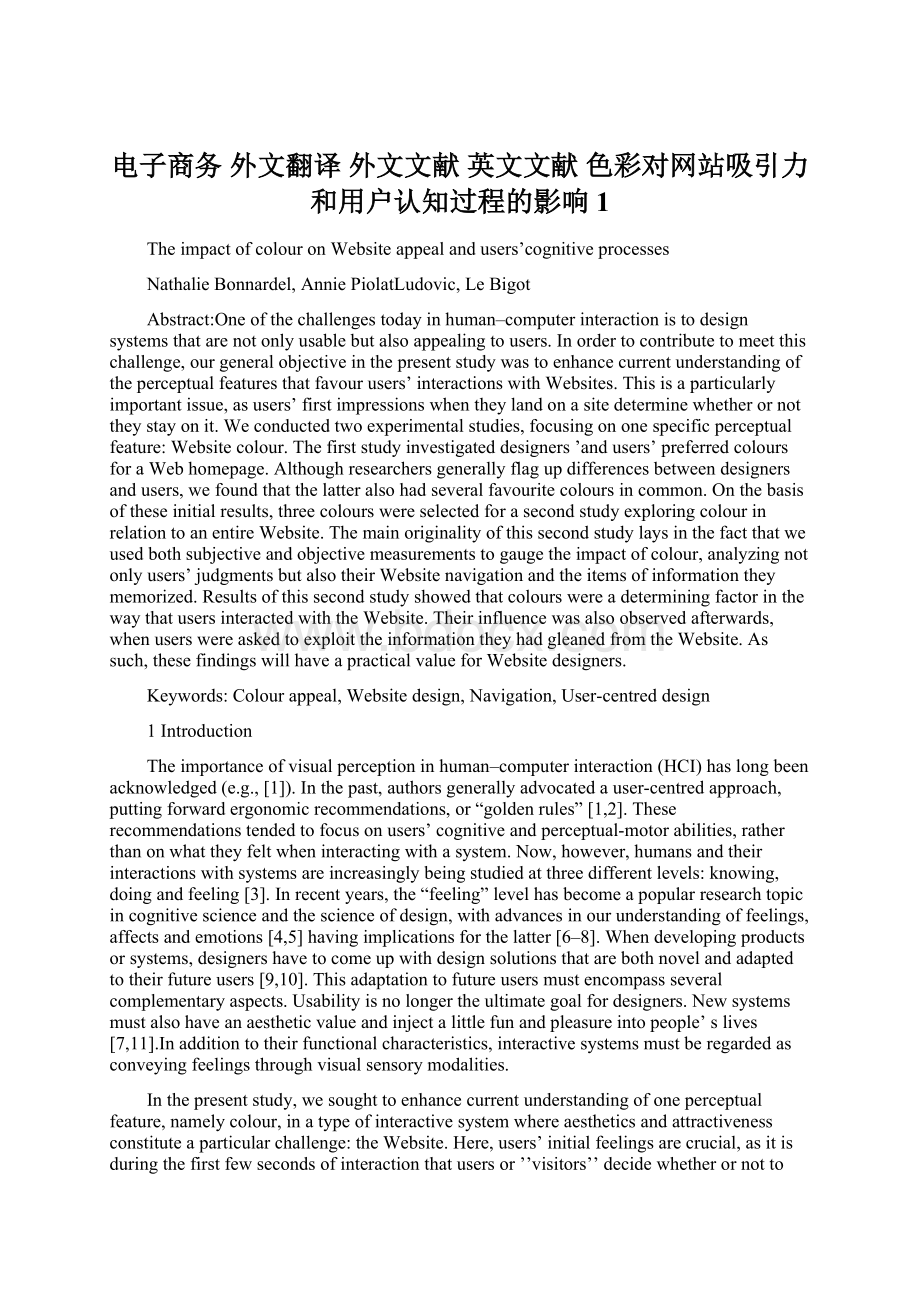电子商务 外文翻译 外文文献 英文文献 色彩对网站吸引力和用户认知过程的影响1Word下载.docx
《电子商务 外文翻译 外文文献 英文文献 色彩对网站吸引力和用户认知过程的影响1Word下载.docx》由会员分享,可在线阅读,更多相关《电子商务 外文翻译 外文文献 英文文献 色彩对网站吸引力和用户认知过程的影响1Word下载.docx(26页珍藏版)》请在冰豆网上搜索。

Abstract:
Oneofthechallengestodayinhuman–computerinteractionistodesignsystemsthatarenotonlyusablebutalsoappealingtousers.Inordertocontributetomeetthischallenge,ourgeneralobjectiveinthepresentstudywastoenhancecurrentunderstandingoftheperceptualfeaturesthatfavourusers’interactionswithWebsites.Thisisaparticularlyimportantissue,asusers’firstimpressionswhentheylandonasitedeterminewhetherornottheystayonit.Weconductedtwoexperimentalstudies,focusingononespecificperceptualfeature:
Websitecolour.Thefirststudyinvestigateddesigners’andusers’preferredcoloursforaWebhomepage.Althoughresearchersgenerallyflagupdifferencesbetweendesignersandusers,wefoundthatthelatteralsohadseveralfavouritecoloursincommon.Onthebasisoftheseinitialresults,threecolourswereselectedforasecondstudyexploringcolourinrelationtoanentireWebsite.Themainoriginalityofthissecondstudylaysinthefactthatweusedbothsubjectiveandobjectivemeasurementstogaugetheimpactofcolour,analyzingnotonlyusers’judgmentsbutalsotheirWebsitenavigationandtheitemsofinformationtheymemorized.ResultsofthissecondstudyshowedthatcolourswereadeterminingfactorinthewaythatusersinteractedwiththeWebsite.Theirinfluencewasalsoobservedafterwards,whenuserswereaskedtoexploittheinformationtheyhadgleanedfromtheWebsite.Assuch,thesefindingswillhaveapracticalvalueforWebsitedesigners.
Keywords:
Colourappeal,Websitedesign,Navigation,User-centreddesign
1Introduction
Theimportanceofvisualperceptioninhuman–computerinteraction(HCI)haslongbeenacknowledged(e.g.,[1]).Inthepast,authorsgenerallyadvocatedauser-centredapproach,puttingforwardergonomicrecommendations,or“goldenrules”[1,2].Theserecommendationstendedtofocusonusers’cognitiveandperceptual-motorabilities,ratherthanonwhattheyfeltwheninteractingwithasystem.Now,however,humansandtheirinteractionswithsystemsareincreasinglybeingstudiedatthreedifferentlevels:
knowing,doingandfeeling[3].Inrecentyears,the“feeling”levelhasbecomeapopularresearchtopicincognitivescienceandthescienceofdesign,withadvancesinourunderstandingoffeelings,affectsandemotions[4,5]havingimplicationsforthelatter[6–8].Whendevelopingproductsorsystems,designershavetocomeupwithdesignsolutionsthatarebothnovelandadaptedtotheirfutureusers[9,10].Thisadaptationtofutureusersmustencompassseveralcomplementaryaspects.Usabilityisnolongertheultimategoalfordesigners.Newsystemsmustalsohaveanaestheticvalueandinjectalittlefunandpleasureintopeople’slives[7,11].Inadditiontotheirfunctionalcharacteristics,interactivesystemsmustberegardedasconveyingfeelingsthroughvisualsensorymodalities.
Inthepresentstudy,wesoughttoenhancecurrentunderstandingofoneperceptualfeature,namelycolour,inatypeofinteractivesystemwhereaestheticsandattractivenessconstituteaparticularchallenge:
theWebsite.Here,users’initialfeelingsarecrucial,asitisduringthefirstfewsecondsofinteractionthatusersor’’visitors’’decidewhetherornottocontinuenavigatingtheWebsite[12–14].Lindgaardetal.[15]showedthatusers’firstimpressionsareconstructedinabout50msandappeartobestableovertime.TheyallowuserstodevelopanaestheticimpressionoftheWebpage,whichinfluencestheirsubsequentnavigation.Sincevisitors’preferencesarebasedontheWebsite’saestheticfeatures[16,17],ourobjectivewastoanalyzeoneparticularperceptualfeaturethatcontributesconsiderablytofirstimpressions:
Websitecolour.Colourshavethepotentialtoaffectourperceptions,emotionalreactionsandbehaviouralintentions[18].However,littleresearchhasbeendoneontheimpactofcoloursinInternet-basedenvironmentsandonlyahandfulofresearchershaveconductedstudiesonthistopicinrecentyearse.g.,[19,20].Withaviewtofillingthisgap,theaimofourstudywastwofold:
–identifyingcoloursthatWebsitedesignersandusersfindappealing;
–determiningwhethersomecoloursfavourWebsitevisitors’navigationandcognitiveprocesses.
Tothisend,wecarriedouttwoexperimentalstudies.ThefirstoneinvestigatedthepreferencesexpressedbydesignersanduserswhentheywereshownWebsitehomepagesin23differentcolours.Thesecondoneanalyzedhowtheuseofthreedifferentcolours(selectedonthebasisoftheresultsfromthefirststudy)inWebsitedesigninfluencedinteractionsbetweenvisitorsandthreedifferentversionsofthesameWebsite.Wearguedthattheroleofcoloursisessentialnotonlywhenaccessingasiteandnavigatingit,butalsoaftertheactualinteractionhascometoanendandusersexploittheinformationtheyhavejustobtainedfromthesite.Beforedescribingthesestudies,wepresenttheirtheoreticalframework,inordertounderlineboththeimportanceofperceptualandaestheticfeatures(e.g.,colours)intermsoftheaffectsoremotionstheyconvey,andtheirinfluenceonusers’interactionswithsystems.
2Emotions,aestheticsandcolours
Foryears,researchersshowedlittleornointerestinthepossiblelinksbetweenemotionandcognition,andbetweenusabilityandusers’emotionsandaestheticfeelings.Onlyrecentlyhavetheysoughttodrawthesedifferentthreadstogether.Wethereforebeginbybrieflycharacterizingemotionsandtheirrelationshipwithcognition,aswellastheirimplicationsforproductdesign(§
2.1).Wethenpointouttherelationshipsbetweenaestheticfeelingsandusers’judgments(§
2.2),aswellasbetweenoneaestheticfeatureinparticular(productcolour)andusers’preferences(§
2.3).
Emotions,cognitionandproductdesign
Thenumerouspapersonthesubjectofemotionsofferdivergentpointsofviewaboutemotionalphenomenae.g.,[21,5,22].Scherer[22]suggesteddistinguishingbetweenvariousaffectivestatesand,inparticular,contrastingutilitarianemotionsandaestheticemotions.Thesetwokindsofemotionresultfromanappraisalofenvironmentalorproprioceptiveinformation,buthavedifferentfunctions.Utilitarianemotions,suchasangerandfear,allowustoadapttoeventsthatmayhavemajorconsequencesforusasindividuals.Theseadaptivefunctionsmayconsistinthepreparationofactions(suchasconfrontationorescape)ortherecuperationandreorientationofwork.Incontrast,aestheticemotionsareunrelatedtotheneedtosatisfyvitalandmandatoryneeds.Forinstance,apersoncanbeimpressed,admiringorfascinated.Thesediffusesensationsdifferconsiderablyfromutilitarianemotionswithregardtofeltarousalandbehaviourorientation.
Althoughemotionisnotunderstoodaswellascognition,bothofthemcanberegardedasinformationprocessingsystems[23],butwithdifferentfunctionsandoperatingparameters.Cognitionallowsustointerprettheworldandmakesenseofit,whereasemotionsaremorejudgmental,assigningpositiveandnegativevalencestotheenvironment[6,7,5].Advancesinourunderstandingofcognitionandemotionsuggestthateachimpactstheother.Thus,severalstudieshaveshownthatemotionsandaffectshaveanimpactonthecognitivefunctioningofindividualsengagedincomplextasks[24,21,25].AccordingtoNorman[7]andCsikszentmihalyi[26],emotionscanevenmakeussmart.Forinstance,positiveaffectsbroadenourthoughtprocessesandseemtoenhanceourcreativityinfindingdesignsolutions[9].Unlikenegativeaffects,positiveaffectsmakedifficulttaskseasiertoperformandmakepeoplemoreflexibleandmoretolerantofminordifficulties[6].
Theseapproacheshaveimplicationsforthedesignofproductsandinteractivesystems.InthefieldofHCI,acognitive–affectivemodeloforganizationalcommunicationhasbeendevelopedbyTe’eni[27].Thisauthorpositsthenotionthatthecommunicationprocess,whichcomprisesthecommunicationmedium(aWebsiteinthecaseofourstudy)andthemessageform(e.g.,differencesinthecoloursusedforaWebsite),hasanimpactontheuserandonwhetherthelatterjudgesthecommunicationtobeappropriate.Inlinewiththismodel,Norman[7]claimsthattheimagewhichproductspresenttotheuser,theirattractivenessandtheuser’sbehaviour,allneedtobeconsidered.Assuch,thedesignofproductsorinteractivesystemsshouldtakethreelevelsofprocessingintoaccount:
–visceraldesign,whichrefersprimarilytotheinitialimpactofproductsandsystemsduetotheirappearance;
–behaviouraldesign,whichisabouttheexperienceofusingaproductorsystem(the“lookandfeel”)andwhichcontributestoitsusability;
–reflectivedesign,whichisabouttheuser’ssubsequentopinionandwhatthelatterhastosayabouttheproductorsystem(e.g.,howitmakeshimorherfeel,theimageitportraysorthemessageitconveys).
Putinaslightlydifferentway,weneedtothinkaboutthreedimensionswhendesigningproducts:
(1)theirattractiveness(orappeal),whichdependsonvisceraldesign,
(2)theirfunctionalandusableproperties,whichresultfrombehaviouraldesign,and(3)their”prestige”,whichisrelatedtoreflectivedesign.Nowadays,therefore,theaimofdesignersistocomeupwithproductsorsystemsthatarenotonlyusefulandusable,butwhicharealsothoughttoconveypositiveemotionsandfeelingsthroughtheiraestheticfeatures.
Aestheticsandusers’judgments
Manyyearsago,socialscientistsdemonstratedtheimportanceofaestheticsineverydaylife.Forinstance,aperson’sph